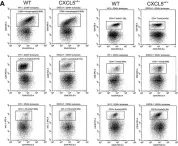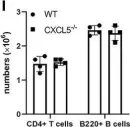Spinal cord injury (SCI) causes nearly all patients to suffer from protracted disabilities. An emerging therapeutic strategy involving the recruitment of endogenous neural stem cells (NSCs) has been developed. However, endogenous NSCs in the adult spinal cord differentiate into mostly astrocytes after traumatic injury, forming glial scars, which is a major cause of regeneration failure in SCI. Thus, understanding which factors drive the activation and differentiation of endogenous NSCs after SCI is critical for developing therapeutic drugs.
The infiltration, state, and location of CD8+ T cells in spinal cord after traumatic injury were analyzed by flow cytometry and immunofluorescence (IF) staining. The Basso Mouse Scale (BMS) scores and rotarod testing were used for motor behavioral analysis. NSCs were co-cultured with CD8+ T cells. EdU assay was used to detect proliferative cells. Western blotting was used to analyze the expression levels of STAT1, p-STAT1, and p27. ChIP-seq and ChIP-qRT-PCR analyses were used to detect the downstream of STAT1. Nestin-CreERT2::Ai9 transgenic mice were used to genetic lineage tracing of Nestin+ NSCs after SCI in vivo.
A prolonged increase of activated CD8+ T cells occurs in the injured spinal cords. The behavioral analysis demonstrated that the administration of an anti-CD8 antibody promotes the recovery of locomotor function. Then, we discovered that CD8+ T cells suppressed the proliferation of NSCs and promoted the differentiation of NSCs into astrocytes by the IFN-γ-STAT1 pathway in vitro. ChIP-seq and ChIP-qRT-PCR analysis revealed that STAT1 could directly bind to the promoters of astrocyte marker genes GFAP and Aldh1l1. Genetic lineage tracing of Nestin+ NSCs demonstrated that most NSCs differentiated into astrocytes following SCI. Depleting CD8+ T cells reduced the differentiation of NSCs into astrocytes and instead promoted the differentiation of NSCs into oligodendrocytes.
In conclusion, CD8+ T cells suppressed the proliferation of NSCs and promoted the differentiation of NSCs into astrocytes by the IFN-γ-STAT1-GFAP/Aldhl1l axis. Our study identifies INF-γ as a critical mediator of CD8+ T-cell-NSC cross talk and a potential node for therapeutic intervention in SCI.
© 2023. The Author(s).
Product Citations: 20
In Inflammation and Regeneration on 13 February 2023 by Wang, J., Xu, L., et al.
-
FC/FACS
-
Mus musculus (House mouse)
-
Immunology and Microbiology
-
Neuroscience
-
Stem Cells and Developmental Biology
CycleFlow simultaneously quantifies cell-cycle phase lengths and quiescence in vivo.
In Cell Rep Methods on 24 October 2022 by Jolly, A., Fanti, A. K., et al.
Populations of stem, progenitor, or cancer cells show proliferative heterogeneity in vivo, comprising proliferating and quiescent cells. Consistent quantification of the quiescent subpopulation and progression of the proliferating cells through the individual phases of the cell cycle has not been achieved. Here, we describe CycleFlow, a method that robustly infers this comprehensive information from standard pulse-chase experiments with thymidine analogs. Inference is based on a mathematical model of the cell cycle, with realistic waiting time distributions for the G1, S, and G2/M phases and a long-term quiescent G0 state. We validate CycleFlow with an exponentially growing cancer cell line in vitro. Applying it to T cell progenitors in steady state in vivo, we uncover strong proliferative heterogeneity, with a minority of CD4+CD8+ T cell progenitors cycling very rapidly and then entering quiescence. CycleFlow is suitable as a routine method for quantitative cell-cycle analysis.
© 2022 The Authors.
In Cancer Cell on 10 October 2022 by Mandula, J. K., Chang, S., et al.
Activation of unfolded protein responses (UPRs) in cancer cells undergoing endoplasmic reticulum (ER) stress promotes survival. However, how UPR in tumor cells impacts anti-tumor immune responses remains poorly described. Here, we investigate the role of the UPR mediator pancreatic ER kinase (PKR)-like ER kinase (PERK) in cancer cells in the modulation of anti-tumor immunity. Deletion of PERK in cancer cells or pharmacological inhibition of PERK in melanoma-bearing mice incites robust activation of anti-tumor T cell immunity and attenuates tumor growth. PERK elimination in ER-stressed malignant cells triggers SEC61β-induced paraptosis, thereby promoting immunogenic cell death (ICD) and systemic anti-tumor responses. ICD induction in PERK-ablated tumors stimulates type I interferon production in dendritic cells (DCs), which primes CCR2-dependent tumor trafficking of common-monocytic precursors and their intra-tumor commitment into monocytic-lineage inflammatory Ly6C+CD103+ DCs. These findings identify how tumor cell-derived PERK promotes immune evasion and highlight the potential of PERK-targeting therapies in cancer immunotherapy.
Copyright © 2022 Elsevier Inc. All rights reserved.
-
FC/FACS
-
Mus musculus (House mouse)
-
Cancer Research
-
Cell Biology
-
Immunology and Microbiology
In Frontiers in Immunology on 7 December 2021 by Guo, L., Li, N., et al.
Respirovirus such as influenza virus infection induces pulmonary anti-viral immune response, orchestration of innate and adaptive immunity restrain viral infection, otherwise causes severe diseases such as pneumonia. Chemokines regulate leukocyte recruitment to the inflammation site. One chemokine CXCL5, plays a scavenging role to regulate pulmonary host defense against bacterial infection, but its role in pulmonary influenza virus infection is underdetermined. Here, using an influenza (H1N1) infected CXCL5-/- mouse model, we found that CXCL5 not only responds to neutrophil infiltration into infected lungs at the innate immunity stage, but also affects B lymphocyte accumulation in the lungs by regulating the expression of the B cell chemokine CXCL13. Inhibition of CXCL5-CXCR2 axis markedly induces CXCL13 expression in CD64+CD44hiCD274hi macrophages/monocytes in infected lungs, and in vitro administration of CXCL5 to CD64+ alveolar macrophages suppresses CXCL13 expression via the CXCL5-CXCR2 axis upon influenza challenge. CXCL5 deficiency leads to increased B lymphocyte accumulation in infected lungs, contributing to an enhanced B cell immune response and facilitating induced bronchus-associated lymphoid tissue formation in the infected lungs during the late infection and recovery stages. These data highlight multiple regulatory roles of CXCL5 in leukocyte chemotaxis during pulmonary influenza infection.
Copyright © 2021 Guo, Li, Yang, Li, Zheng, Yang, Chen, Zhao, Mei, Shi, Worthen and Liu.
-
FC/FACS
-
Mus musculus (House mouse)
-
Cardiovascular biology
-
Immunology and Microbiology
In Acta Pharmaceutica Sinica. B on 1 October 2021 by Chen, J., Qiao, Y., et al.
mediated cancer therapy has achieved remarkable anti-tumor effects in experimental animal models, but the detailed mechanism remains unsolved. In this report, the active involvement of the host immune response in this process was confirmed by comparing the tumor-suppressive effects of Salmonella in immunocompetent and immunodeficient mice bearing melanoma allografts. Since flagella are key inducers of the host immune response during bacterial infection, flagella were genetically disrupted to analyse their involvement in Salmonella-mediated cancer therapy. The results showed that flagellum-deficient strains failed to induce significant anti-tumor effects, even when more bacteria were administered to offset the difference in invasion efficiency. Flagella mainly activate immune cells via Flagellin/Toll-like receptor 5 (TLR5) signalling pathway. Indeed, we showed that exogenous activation of TLR5 signalling by recombinant Flagellin and exogenous expression of TLR5 both enhanced the therapeutic efficacy of flagellum-deficient Salmonella against melanoma. Our study highlighted the therapeutic value of the interaction between Salmonella and the host immune response through Flagellin/TLR5 signalling pathway during Salmonella-mediated cancer therapy, thereby suggesting the potential application of TLR5 agonists in the cancer immune therapy.
© 2021 Chinese Pharmaceutical Association and Institute of Materia Medica, Chinese Academy of Medical Sciences. Production and hosting by Elsevier B.V.
-
FC/FACS
-
Mus musculus (House mouse)
-
Cancer Research
-
Immunology and Microbiology
In Front Immunol on 7 December 2021 by Guo, L., Li, N., et al.
Fig.5.A

-
FC/FACS
-
Mus musculus (House mouse)
Collected and cropped from Front Immunol by CiteAb, provided under a CC-BY license
Image 1 of 4
In Front Immunol on 7 December 2021 by Guo, L., Li, N., et al.
Fig.5.D

-
FC/FACS
-
Mus musculus (House mouse)
Collected and cropped from Front Immunol by CiteAb, provided under a CC-BY license
Image 1 of 4
In Front Immunol on 7 December 2021 by Guo, L., Li, N., et al.
Fig.5.I

-
FC/FACS
-
Mus musculus (House mouse)
Collected and cropped from Front Immunol by CiteAb, provided under a CC-BY license
Image 1 of 4
In PLoS One on 3 October 2012 by Comerford, I., Litchfield, W., et al.
Fig.6.A

-
FC/FACS
-
Mus musculus (House mouse)
Collected and cropped from PLoS One by CiteAb, provided under a CC-BY license
Image 1 of 4



